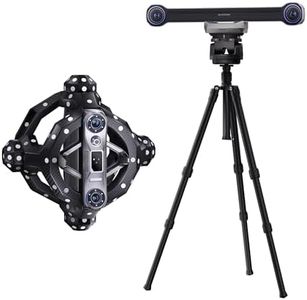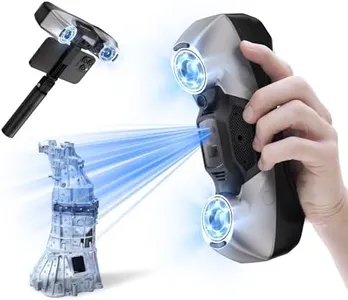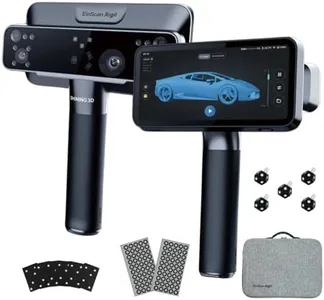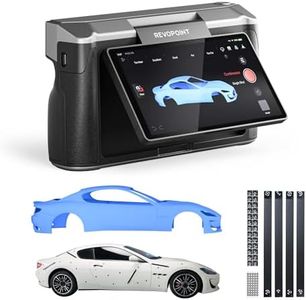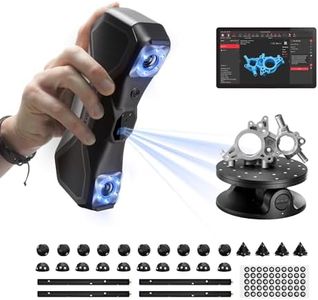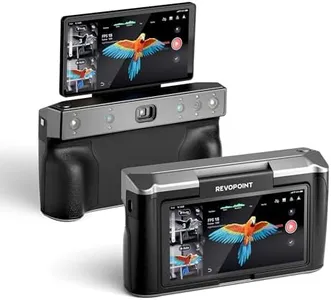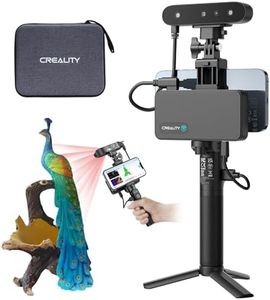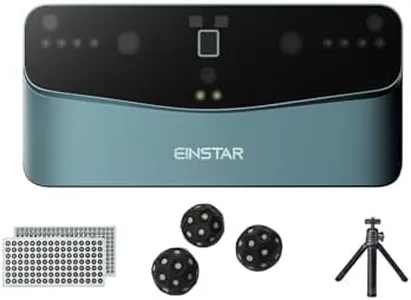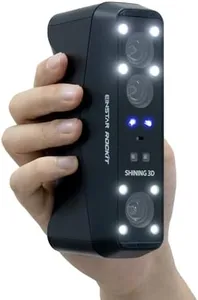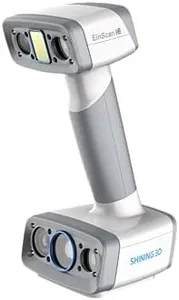10 Best 3D Scanners 2025 in the United States
Our technology thoroughly searches through the online shopping world, reviewing hundreds of sites. We then process and analyze this information, updating in real-time to bring you the latest top-rated products. This way, you always get the best and most current options available.

Our Top Picks
Winner
Revopoint Trackit 3D Scanner for 3D Printing, Metrology-Grade Precision 0.02mm, Blue Laser Scans, Marker-Free Scans, Ultra-Realistic Texture Mapping for 3D Modeling
Most important from
35 reviews
The Revopoint Trackit 3D Scanner stands out for its impressive precision, boasting a resolution and accuracy of up to 0.02mm, which is excellent for professional use in industrial quality control, reverse engineering, and detailed modeling. Its dual scanning modes (30-line cross-laser and single-line laser) offer flexibility to scan both large and small objects effectively. A key strength is its marker-free optical tracking system, allowing you to scan without placing sticky markers on your subject, making the process more convenient and less intrusive.
The scanner covers a wide working distance of up to 4 meters, providing versatility for different scanning tasks—from small parts to large industrial components. Portability is decent, as the device is lightweight and built from strong materials, suitable for demanding environments, and it can be used handheld for scanning hard-to-reach spots. Software compatibility is strong with the included Revo Track app, which simplifies scanning, mesh creation, and editing, and supports exporting data to other CAD software for further work. Real-time visualization of scan quality helps ensure accurate results during use.
While the scanner is designed for ease of use, getting comfortable with dual scan modes and software functions might require some initial time. Additionally, thorough scanning at high precision can be time-consuming. For those needing detailed texture mapping and measurement-grade results, the Revopoint Trackit offers a reliable scanner that combines professional-grade accuracy with versatile scanning options and user-friendly software.
Most important from
35 reviews
Revopoint MetroY Pro 3D Scanner for 3D Printing, Up to 0.01mm Precision, 34+15+1 Industrial Blue Laser Handheld Scanner, 62-Line Full-Field, Real-time Preview, Bulit-in Wi-Fi 6, Full-Color 3D Scan
Most important from
35 reviews
The Revopoint MetroY Pro is a handheld 3D scanner designed to deliver very high precision, boasting up to 0.01 mm resolution and 0.02 mm accuracy, which is excellent for detailed projects like 3D printing or reverse engineering. Its advanced blue laser technology and five scanning modes—including a fast 62-line full-field mode—allow it to capture a variety of objects, even shiny or dark surfaces, without needing special sprays. Scanning speed reaches up to 1.7 million points per second, helping you complete jobs quickly.
Portability is well thought out with included accessories like a power bank handle and carrying case, and the scanner supports wireless connection through built-in Wi-Fi 6 for more flexible use without cables. The software package is user-friendly and integrates smoothly with professional platforms, with macOS support coming soon. The MetroY Pro also features a convenient auto turntable mode for scanning complex objects effortlessly and real-time temperature monitoring to maintain scan accuracy.
This scanner is an excellent choice for hobbyists and professionals who value precision, speed, and versatile scanning options in a portable setup. The comprehensive package and good support make it easy to get started, and it suits various scanning needs across different projects.
Most important from
35 reviews
Shining 3D EinScan Rigil 3D Scanner All-in-one Wireless 19+19 Crossed Laser Lines, 7 Parallel Laser Lines, VCESL Infrared, Marker Free Blue Laser 3D Scanners, 0.04mm High Volumetric Accruacy
Most important from
1 reviews
The Shining 3D EinScan Rigil is a versatile 3D scanner designed for professional and industrial use, offering excellent accuracy and flexibility. Its standout feature is the high volumetric accuracy of 0.04mm + 0.06mm/m, which ensures very precise scans, making it suitable for detailed and quality-demanding projects. It supports three scanning modes: standalone (no PC needed), wireless PC, and wired PC, providing great portability and adaptability depending on whether you need mobility or maximum data processing power.
The scanner employs multiple blue laser lines and an infrared light source, allowing it to effectively handle objects that are dark or reflective without requiring surface treatment like spraying. This is a significant advantage when scanning tricky materials. Another plus is the marker-free scanning capability, which simplifies setup and speeds up the process compared to traditional marker-based systems. It also comes with professional EXScan Rigil software that offers a full workflow from scanning to editing, which is user-friendly but still powerful for complex tasks.
Despite its strengths, the scanner is relatively heavy at over 10 pounds, which might limit portability for some users. While wireless scanning is supported, the maximum speed and data volume are best achieved in wired mode, so in environments with unstable networks, performance could be impacted. The price and complexity might be more than casual users or beginners need, as it’s clearly aimed at industrial or professional use. The EinScan Rigil excels in accuracy, flexibility, and handling difficult surfaces, making it a solid choice for professionals seeking a reliable and precise 3D scanning solution, though it may be less convenient for lightweight or casual scanning needs.
Most important from
1 reviews
Buying Guide for the Best 3D Scanners
Choosing the right 3D scanner can be a game-changer for your projects, whether you're into product design, quality control, or even art and heritage preservation. The key to finding the best fit for you is understanding the different specifications and how they align with your specific needs. Here are some important specs to consider when selecting a 3D scanner.FAQ
Most Popular Categories Right Now


